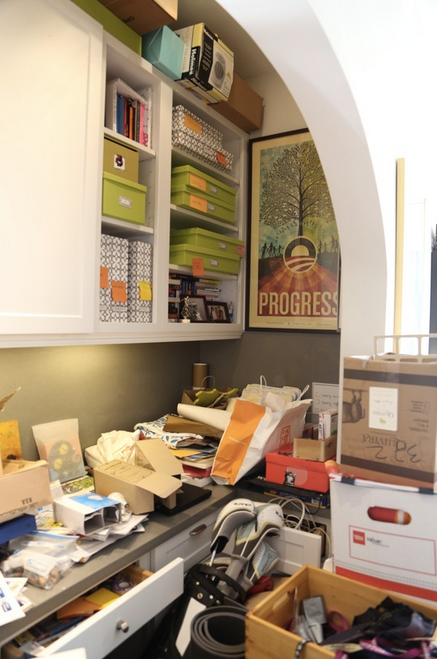7 Places Organization Goes to Die -- How Many Do You Use in Your Home?
After: bed is clear, both on the surface and underneath.
Organized or not, clutter is clutter.
Take a glance at the photos in Real Simple or Martha Stewart magazines, the Container Store or Pottery Barn catalogues. Each of these publications offers up a multitude of organization systems. Everything from color-coded binders to hold all of your old magazines and catalogues to a hanger for your 50 most favorite belts.
These companies say they are selling you organization, but what they're really selling is a get out of jail free card for your clutter.
After all, if you have a hanger for 50 belts, then you never need to deal with the fact that you only wear 2 of them. Our belief at New Minimalism is that when you simplify, there is a natural order, organization and beauty that emerge.
Think about having your 10 favorite shirts on beautiful hangers versus having 80 shirts in all kinds of drawers and contraptions. True organization is easily established and maintained only when the right items are being organized to begin with. The best, most effective, most long lasting organization is the kind that emerges when you only have what is necessary and loved around. There is always enough space for that.
Below are the 7 most commonly used, well-intentioned techniques and items that people use when they are “trying to get organized.”
These are the "black holes of organization" -- the places that unwanted and unneeded items go to collect dust and take up physical and psychic space until we make the decision to let them go. Take some time today to let those extra items under your bed or on your highest shelf go.
7 Places Organization Goes to Die
1. Under the bed bins.
Initially purchased to make due with a normal person's wardrobe in the the 10’ x 10’ cells known as college dorm rooms, these terrible items have made their transition to the adult homes of many of our clients.
Not only is keeping rarely used items in plastic unfavorable for their scents and the breathability of materials, these items are often completely forgotten about once hidden under the bed skirt. They also make it far more difficult to clean beneath your bed contributing to dust bunnies and allergies.
And finally, most importantly to me, having junk under your bed is seriously bad Feng Shui. You are literally charging the one place that is supposed to be for rest and intimacy with the static and complicated energy of extra bath towels or hoarded hotel shampoos. If you're not a great sleeper or are single and looking to partner, check around your bed for your first round of decluttering -- your sex life depends on it! (Just kidding... kind of:)
Before: bins, bins, bins!
2. Plastic dressers/drawers.
Anyone who has worked with us knows that I absolutely despise plastic dressers. This is deeply related to under bed bins but also a realm unto itself. These micro-dressers were similarly of great use in college, holding all types of pens, undergarments and odds and ends when we had to downsize from a real closet to a faux-wardrobe. But as an adult, these bins simply become a holding pen for junk that should be tossed.
As we know, clutter attracts more clutter. And these shoddily made bins, easily coming off kilter and challenging to open and close, are essentially a clutter magnet. Basically, I’ll say this: I’ve never come across a set of plastic drawers with a client where at least 60% didn't go directly to be trashed/recycled/donated. If you clear any clutter from your life today, please start here!
3. Dry cleaning bags/hangers.
Many people feel that keeping their nice clothes in their dry cleaning bags will remind them that they are clean and make them easy to pack. Instead, your items spend months sitting in the mildly toxic gasses that were used to clean them. They are harder to organize, make your closet immediately look ugly, and make items far harder to find and actually use. So please, as soon as you come home from the cleaner take those bags and hangers off before hanging items in your closet (and don’t forget to return the hangers for re-use on your next visit!).
4. Specialized hangers/organization tools.
I’m looking at you 50-tie hanger, entire jewelry dresser, and million loop scarf holder. All of these things create singularly utilizable space that encourages us to have far more than we need or want.
Think about it: if you have room for 50 pairs of earrings and only 5 pairs you love, wouldn't it feel a bit sad or weird to look at such and empty box? Wouldn't you want to go out and buy something to make the box look more full and beautiful? Instead, choose what you love and then find the proper storage afterwards.
Before: color-coded and super high storage contributing to the chaos in a home office, rather than taming it.
5. Super high up shelves.
My favorite thing about Kyle (besides her impeccable style and occasionally side-splitting jokes) was that she introduced me to her philosophy on tall storage, “If you can’t easily reach it, it should be empty or used strictly for subtle decoration." It's pretty obvious, but if you can't reach it, you probably don't need it.
6. Storage units.
If you don’t use it often enough, you’ll never use it. Most people rarely access their units. The things they’ve saved there “just in case” end up being repurchased and filling their home again anyway. Consider what life might be like without the things in storage -- specialty items or things you only use once a year, items from past generations that no one uses. Would you even notice any specific thing if it went missing? Are you holding onto all of these things for some unforeseeable future when you "might need a dining table that seats 12?" Consider the costs, financial and otherwise, of holding all these items in a controlled temperature, padlocked purgatory...
7. Overwrought color-coded and alphabetized systems.
Now I have seen people experience great success in alphabetizing a small spice rack or favorite vinyl albums. These items are in constant use and the system promotes efficiency and ease.
What doesn’t work? Organizing years worth of backlogged Sports Illustrated or People Magazines or Sunday Crosswords. There is a point where we allow organization to act as a substitute for much needed decluttering. Rather that getting all your old Economists in date-order, let them all go (old news is old news after all) and instead spend your time reading and recycling your current issue each week.

